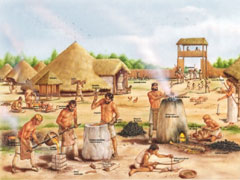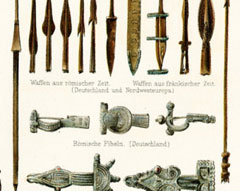The Neolithic period is followed by Chalcolithic (copper-stone) period when copper and bronze came to be used. The new technology of smelting metal ore and crafting metal artifacts is an important development in human civilization.
But the use of stone tools was not given up. Some of the micro-lithic tools continued to be essential items. People began to travel for a long distance to obtain metal ores. This led to a network of Chalcolithic cultures and the Chalcolithic cultures were found in many parts of India.
 |
| Metal Age People |
Generally, Chalcolithic cultures had grown in river valleys. Most importantly, the Harappan culture is considered as a part of Chalcolithic culture. In South India the river valleys of the Godavari, Krishna, Tungabhadra, Pennar and Kaveri were settled by farming communities during this period. Although they were not using metals in the beginning of the Metal Age, there is evidence of copper and bronze artifacts by the end of second millennium B.C. Several bronze and copper objects, beads, terracotta figurines and pottery were found at Paiyampalli in Tamil Nadu.
 |
| Metal Age Tools |
The Chalcolithic age is followed by Iron Age. Iron is frequently referred to in the Vedas. The Iron Age of the southern peninsula is often related to Megalithic Burials. Megalith means Large Stone. The burial pits were covered with these stones. Such graves are extensively found in South India. Some of the important megalithic sites are Hallur and Maski in Karnataka, Nagarjunakonda in Andhra Pradesh and Adichchanallur in Tamil Nadu. Black and red pottery, iron artifacts such as hoes and sickles and small weapons were found in the burial pits.



